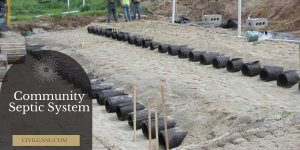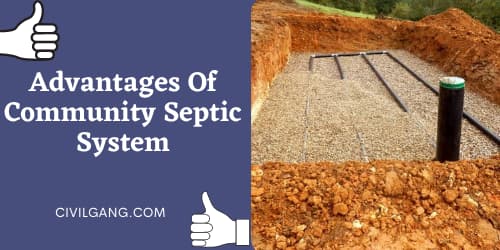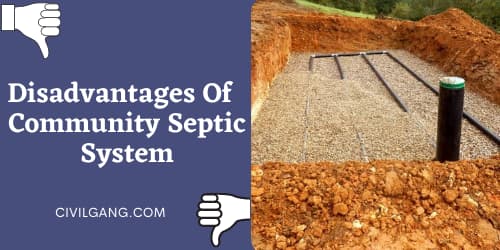Introduction Community Septic System
The underlying soil is used to help treat wastewater in most traditional community septic systems. However, because unfiltered water seeps into the earth, this approach to wastewater management can pose major environmental problems.
Septic systems that use leach fields or other soil-dependent treatment techniques can cause aquifer contamination, soil erosion, and habitat damage, to name a few issues.
When treating wastewater for large neighborhoods and municipalities, these concerns become even more pronounced. Worse yet, most municipal and community septic systems have a slew of continuing expenses such as upkeep, cleanup, and repair.
Using tax funds to pay for these costs isn’t always the greatest idea.
Following this,
- The treatment and dispersion of water are done in the same tiny area.
- There is no contamination of the soil or the groundwater.
With an increasing number of subdivision projects taking place in non-sewered rural or semi-rural regions, determining the best wastewater systems and structures to service those developments for optimum development value, long-term profitability, and environmental stewardship takes some thinking.
For best long-term performance, the systems must be cost-effective, efficient, and simple to maintain.
The community onsite wastewater system is one possible alternative (also known as community or mass drain fields, offsite systems, or decentralized systems).
A decentralized wastewater treatment system that gathers wastewater from two or more houses or buildings and transports it to a treatment and dispersal system placed on a suitable site near the dwellings or structures under some kind of community ownership. Cluster systems are common in places like rural subdivisions.
What Is a Community Septic System?
Each family home used to have its own well and septic system. It is possible to save time, money, and give a much better experience for inhabitants, developers, and the environment by developing subdivisions in rural areas and utilising some unique industry technologies.
In some ways, a communal onsite wastewater system is similar to a residential septic system. Each home has a septic tank that collects wastewater and separates the sludge (solids that are thicker) from the effluent.
In a typical arrangement, wastewater exits the tank and is scattered across layers of soil via a drainfield before being reintroduced into the groundwater source as clean water.
The effluent from several septic tanks is collected and pumped to a single, larger drainfield that all of the residences share in a communal onsite wastewater system. Prior to final dispersal, this wastewater is increasingly passing through a treatment system.
Community onsite wastewater systems make it easier and more flexible to build lots, providing developers and residents additional options. Because each lot must be able to accommodate a drainfield for each dwelling in traditional septic systems, the size (and shape) of each lot is restricted.
Developers can give homeowners more alternatives in terms of lot size by incorporating a centralised drainfield into a community’s onsite wastewater system. Some families may prefer larger lots with greater space at a higher price point, but others may prefer a smaller lot for easier upkeep or a lower price range.
Developers and builders have greater alternatives in terms of dwelling design when distinct drain fields aren’t required for each lot. When drain fields are installed on-site, special care must be taken to ensure that they function correctly; driveways or parking lots cannot be built above them.
Vehicle weight and pressure can cause soil compaction and blockage (or even worse, crushing the leach lines). With a shared or mass drainfield, however, builders and homeowners have more options for roadways, garage entrances, and home orientation on the site.
Homeowners that do not have a septic system on their property have more usable lot space for pools, sheds, and mother-in-law quarters, among other things.
Developers can also address heterogeneity in soil and conditions on individual properties by using a community drainfield design. Lots with poor percolation rates or a limited groundwater supply may not be suitable for a standard septic system, but they might benefit from a shared community system.
Developers do not need to dig as much land to fit a drainfield for each house when a communal onsite wastewater system is built.
As a consequence, developers may retain more useable lot space, mature vegetation, and hardwoods on each lot. This increases the appeal of the homes to prospective purchasers as well as the surrounding community. More of the natural ecosystem is conserved as a result of reduced deforestation.
It’s typical for the area above ground to be designated green space when developers prepare for the bulk drainfield that the individual houses will tie into. Small parks, playgrounds, dog-walking pathways, and other recreational activities can be accommodated in the bigger, more open spaces. These features add to the appeal of living in a community.
Community Septic System Cost
Residents generally share the expense of operating an onsite wastewater system through a monthly or yearly charge (sometimes included in homeowners’ association dues). When these community systems include treatment, it essentially ensures that the community drain fields will not fail as predicted in untreated on-lot drain fields.
Although some residents prefer a conventional septic system since it removes monthly fees associated with a shared system, on-lot systems still have maintenance expenditures, such as tank pump outs and eventual drain field failure and replacement.
Individual septic systems typically require maintenance every three to five years, with national pumping and cleaning expenses average $383. (Home Advisor). Homeowners who flush personal items unwittingly, grow trees over a drainfield, or park cars on the ground above a drainfield, creating soil compaction, add to the routine maintenance requirements.
A clogged drainfield or a poorly performing septic system might occur as a result of a homeowner’s lack of knowledge and comprehension, necessitating more maintenance. If a system is disregarded and continues to work poorly for an extended period of time, substantial repairs may be required, which can cost thousands of dollars.
Most septic systems have a 15- to 25-year lifespan, with labour and landscaping expenses easily reaching $10,000 to replace or repair a damaged system.
Residents who utilize a community wastewater treatment system can use their home and yard in the same way as homeowners who use municipal sewer can without fear of causing thousands of dollars in property damage.
| Types of Septic Tanks | Advantage | Disadvantage |
| Concrete | Life span of several decades | Prone to cracking |
| Steel | Life span of up to 25 years | Prone to rust corrosion |
| Fiberglass or Plastic | Rust-proof and not prone to cracking | Lightweight material makes it vulnerable to above-ground pressure |
| Aerobic | Highly efficient; requires smaller drain fields | Runs on electricity; costly to install and maintain |
Advantages of Community Septic System
Here, the pros of community spect system are as follows.
- Septic tank designs come in a variety of shapes and sizes, each with its own set of benefits in terms of longevity and simplicity of maintenance. The benefits and drawbacks of a specific septic tank are primarily determined by the material used in its construction.
- Dedicated to single-family homes. When you handle your septic tank on your own rather than relying on the local town or city government, you gain ownership and freedom. This improves the efficiency of the system.
- The costs of installing a new septic system is generally cheaper than the cost of installing municipal sewage lines. If your house or business is located on a site larger beyond one acre, a septic system may be very cost-effective.
- To save money on city-mandated monthly payments because a septic system is independent of a municipal sewer system.
- The septic system should last for several years if you maintain it properly, maybe for the whole time you live in your house or company.
- Septic systems are said to be better for the environment since they don’t pollute groundwater as potentially leaking sewage lines may. When a septic system fails, the harm is limited to a single piece of property and does not have city-wide ramifications.
- Septic tanks reduce pollutants in the earth by filtering it naturally through drainfields or leachfields. Any germs present in the effluent have been eliminated by the time it reaches the field.
- Septic tanks’ water-recycling technology is also helpful to the surrounding flora and animals. Plant development is aided by the treated water, which offers food for insects, birds, and other small animals.
- A well-built and well-maintained septic system can survive for 40 years or longer.
- To keep your septic system functional for numerous years, get it examined and maintained every one to three years and follow good septic-related behaviours.
Disadvantages of Community Septic System
Here, the cons of community spect system are as follows.
- Although septic tanks are designed to endure for decades, they will eventually fail and need to be replaced, depending on the model you have. This scenario necessitates work and, yes, money.
- A new septic tank, including the equipment and installation fees, may easily cost $5,000 or more. Poor maintenance and excessive chemicals going down the drains reduce the efficiency of a septic system.
- Installing and maintaining a septic tank system may be fairly costly, depending on consumption levels as well. A septic system requires electricity to operate, which adds to the expense. The amount of property residents and their bathroom, kitchen, and laundry routines determine the frequency of upkeep.
- The septic tank’s contents should be flushed out at least once every two or three years. If the tank isn’t pumped, it might cause fast blockage in your drain field, causing it to fail prematurely.
- This isn’t always a bad thing, but everyone should practice consistent and careful water consumption practices (showers, laundry, and dishwashing). Large amounts of water might put a strain on your drain lines and septic tank.
- Similarly, water fixtures must be examined for leaks on a regular basis to ensure that they are not adding to the volume of water entering your septic tank.
- With a septic tank, you’ll have to be extra cautious about what you put down your drains and toilets. Septic systems may be damaged by household chemicals, oil and grease, and other non-biodegradable materials, resulting in sewage backups and maintenance expenses.
- Property Responsibilities that aren’t included in the above list. If your septic system fails, you are accountable. When your home is connected to a municipal sewer line, the only pipes on your property that need to be considered are those on your own property.
- The rest is under the jurisdiction of your local government. If something goes wrong with a septic tank, you’re on the hook. You’ll also have to keep an eye on the logistics of your property.
- Tree roots may penetrate and damage your drain field lines if they grow close to them. Swimming pools (in-ground or above-ground) must also be kept away from drain field lines.
Like this post? Share it with your friends!
Suggested Read –
- Green Septic System
- Leach Line Repair Cost
- Alternatives to Septic Tanks
- Septic Tank Leaking into Yard
- What Are the 3 Types of Septic Systems?
- How Much Is It to Empty a Septic Tank
- All About of Constructed Wetland | What Is Constructed Wetland | Types of Constructed Wetlands | Constructed Wetland Septic System Cost
- What is Brick Septic Tank | How Brick Build Septic Tanks Are Designed | Life of a Brick Septic Tank | How Does a Brick Built Septic Tank Work
- What Is Chamber Septic System | How Much Does a Chamber Septic System Cost | Chamber Septic System Maintenance
- Alternative Septic Systems | What Are Alternative Septic Systems | Types of Alternative Septic Systems
- Skillion Roof House | Types of Skillion Roof | How to Build Skillion Roof | Advantages & Disadvantages




It was really interesting to me when you mentioned that a precast concrete septic tank is the best kind. I would imagine that concrete is a great material for this kind of system because it isn’t permeable. Since concrete isn’t permeable, waste products aren’t going to be able to leak through.